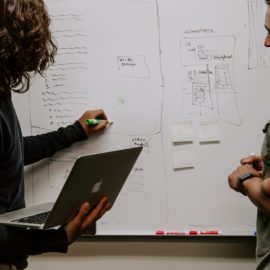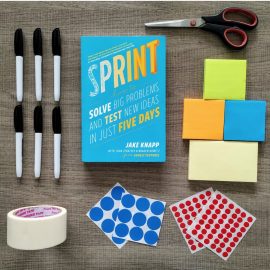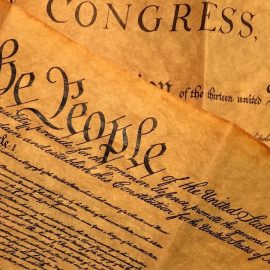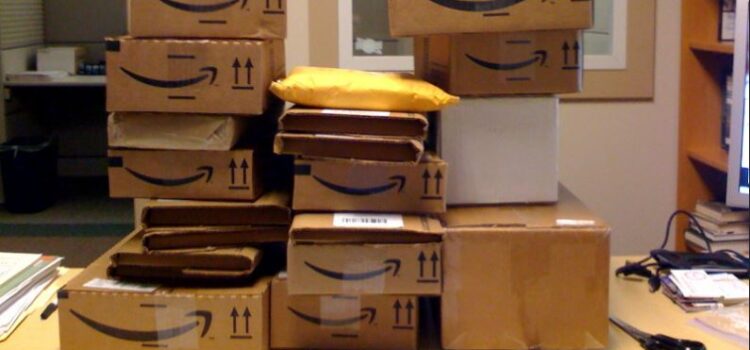
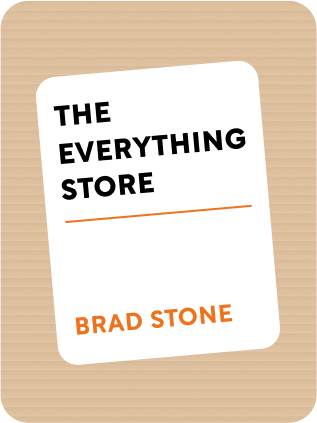
This article is an excerpt from the Shortform book guide to "The Everything Store" by Brad Stone. Shortform has the world's best summaries and analyses of books you should be reading.
Like this article? Sign up for a free trial here .
How did Amazon grow so quickly after it’s conception in 1994? What happened in Amazon’s early days?
From 1996 to 1999, Amazon grew rapidly. Amazon went from strictly selling books to selling DVDs, music, and toys. But they weren’t the only large, online store—eBay entered the scene.
Continue on to learn about Amazon’s growth from a bookstore to an everything store.
Amazon’s Growth
Below is the timeline that tracks Amazon’s growth from 1996 to 1999:
Amazon in 1996
June 1996: Amazon raises $8 million from Kleiner Perkins and John Doerr at a valuation of $60 million.
- Kleiner wants to put a junior member on the board, but Bezos requires famous investor Doerr in that position as part of the deal. He believes Doerr’s involvement is a public vote of confidence.
- People observe that this money enables Bezos, making him think bigger and move faster than before. The motto is now “Get Big Fast.” He believes that they are always at threat of a larger player taking away what they have. He also believes the company that gets the lead now would keep it.
- Using this money, Amazon begins hiring executives from other companies, some away from tech companies like Microsoft.
Summer 1996
- Amazon launches its affiliate marketing program, giving an 8% commission for sales referrals.
- They have 150 full-time employees, with fewer than 50 in the warehouse. They move offices again, and soon the warehouse expands to a 93,000 square-foot place.
- Bezos wants Amazon to IPO (just 2 years after founding).
- This enables global branding that solidifies Amazon in customers’ minds.
- It would help compete with Barnes & Noble, which has plans to go online.
Fall 1996
- Amazon releases Similarities, recommendations for new books to buy. It’s based on previous order history and groups similar users together.
Amazon in 1997
Early 1997
- Amazon had $16 million in sales in 1996, compared to $2 billion for Barnes & Noble.
- Amazon continues hiring executives from outside, threatening the status of some early employees like employee #1 Shel Kaphan (who is later indeed sidelined and leaves out of frustration).
- Starbucks proposes a deal to put Amazon next to cash registers in exchange for 10% equity. Starbucks CEO Howard Schultz argues Amazon needs a physical presence, but Bezos disagrees. Bezos was envisioning Starbucks having a much lower 1% equity. The deal doesn’t happen.
- Amazon continued the IPO process, choosing the bankers Deutsche Bank and Frank Quattrone (whose lead analyst was Bill Gurley, now a VC at Benchmark).
- They boast of their “negative operating cycle,” receiving money from customers immediately but paying their distributors every few months. In between, they have capital to fund expansion.
- They boast of a high revenue to fixed cost ratio, meaning a dollar invested in Amazon could provide much better returns than with any physical retailer.
- Bezos keeps mum on some details, like customer acquisition cost and average purchase order, to prevent rivals from following their game plan.
May 15, 1997: Amazon IPOs, raising $54 million at a starting price of $18 per share.
- The widespread attention helps contribute to a growth of 900% in annual revenue.
- Three days before the IPO, Barnes & Noble sues Amazon, alleging false advertising for being “Earth’s Largest Bookstore.” This has a Streisand effect, drawing even more attention to Amazon.
End of 1997: Amazon has $148 million in revenue, up from $16 million in 1996.
Amazon in 1998
Spring 1998: Bezos considers it imperative to expand Amazon’s brand beyond books to become the Everything Store. Amazon begins researching new product categories that have a high number of SKUs (unique products), are underrepresented in physical stores, and can be sent through the mail.
- Music and DVDs were the first targets for Amazon to tackle. Amazon quickly surpasses older tech incumbents CDNow.com and Reel.com.
May 1998: Amazon raises $326 million in junk-bonds to fund expansion.
June 1998: Amazon introduces Amazon Sales Rank, providing exact sales ranks for all books beyond the top 100 bestsellers.
- This causes addictive rank checking for authors and publishers.
1998: In the heat of the Internet boom, Amazon becomes a venture capital investor, investing tens of millions in Drugstore.com, Pets.com, Gear.com, Homegrocer.com, and Kozmo.com.
Summer 1998: Bezos meets with eBay founder Pierre Omidyar and CEO Meg Whitman.
- eBay is growing fast, from $47 million in revenue in 1998 to $225 million in 1999. It threatens to intercept Amazon as the Everything Store.
- eBay’s business model is strong, taking commissions for each sale but none of the hassle of inventory and sending packages. It’s possible that eBay becomes so pervasive it’d obviate fixed-price retailing.
- No partnership is made, but Bezos initiates a secret auctions project to replicate eBay in three months.
December 1998: Henry Blodget at Oppenheimer predicts that Amazon’s stock price would hit $400 per share in the next 12 months.
- It actually hits $400 just three weeks later.
End of 1998: Amazon has $610 million in revenue, up from $148 million in 1997 and $16 million in 1996.
Amazon in 1999
Early 1999: After the success in music and movies, Bezos chooses to expand to toys and electronics.
- Toys prove fundamentally different from previous categories.
- Unlike books and music, no third-party distributors could provide any item and take back unsold inventory. Instead, the toy makers carefully allocate supply to each retailer. For the first time, Amazon has to beg for supply.
- Retailers have to predict in advance what the next holiday’s top toys will be, since most sales occur within a 6-week period. If they’re wrong, they’ll end up with unsold inventory.
- Despite this, Bezos insists on spending $120 million on stocking every toy so customers would never end up disappointed.
- Similarly, electronics proves more difficult; manufacturers view Internet sellers warily as likely to discount their products. Cut off, Amazon turns to gray-market secondary distributors.
February 1999: Amazon raises $1.25 billion in convertible debt at 4.75% (cheap capital at the time).
- It uses capital for acquisitions (IMDB, BookPages, Exchange.com), building five new distribution centers, and partnering with portals like AOL, Yahoo, and MSN to become their exclusive booksellers. Normal deals of this nature usually involve giving the portals equity, but Bezos insists on paying cash.
March 1999: Amazon Auctions (the eBay clone Bezos ordered in 1998) launches to limited success.
- eBay has incredibly strong network effects that Amazon finds hard to penetrate, even despite Amazon offering lower listing fees and free fraud insurance.
- Furthermore, the effort is not full-hearted within the company, having limited promotion – customers can reach Auctions only by clicking on a tab on the Amazon homepage.

———End of Preview———
Like what you just read? Read the rest of the world's best book summary and analysis of Brad Stone's "The Everything Store" at Shortform .
Here's what you'll find in our full The Everything Store summary :
- How Amazon went from an online bookstore to the largest internet retailer in the world
- What Jeff Bezos did to compete with companies like eBay, Zappos, and Diapers.com
- What it was like to work for Jeff Bezos




